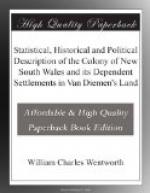Of all the fruits which I have thus enumerated as being produced in this colony, the peach is the most abundant and the most useful. The different varieties which have been already introduced, succeed one another in uninterrupted succession from the middle of November to the latter end of March: thus filling up an interval of more than four months, and affording a wholesome and nutritious article of food during one-third of the year. This fruit grows spontaneously in every situation, on the richest soils, as on the most barren; and its growth is so rapid that if you plant a stone, it will in three years afterwards bear an abundant crop of fruit. Peaches are, in consequence, so plentiful throughout the colony, that they are every where given as food to hogs; and when thrown into heaps, and allowed to undergo a proper degree of fermentation, are found to fatten them very rapidly. Cider also is made in great quantities from this fruit, and when of sufficient age, affords a very pleasant and wholesome beverage. The lees, too, after the extraction of the juice, possess the same fattening properties, and are equally calculated as food for hogs.
Rearing of cattle, etc.
The system of rearing and fattening stock in this colony is simple and economical. Horses, in consequence of their rambling nature, are almost invariably kept in enclosures. In the districts immediately contiguous to Port Jackson, horned cattle are followed by a herdsman during the day, in order to prevent them from trespassing on the numerous uninclosed tracts of land that are in a state of tillage, and they are confined during the night in yards or paddocks. In the remoter districts, however, which are altogether devoid of cultivation, horned cattle are subjected to no such restraints, but are permitted to range about the country at all times. The herds too are generally larger; and although a herdsman is still required as well to prevent them from separating into straggling parties, as to protect them from depredation, the expence of keeping them in this manner is comparatively trifling, and the advantages of allowing them this uncontrouled liberty to range, very great; since they are found during the heat of summer to feed more in the night than in the day. This, therefore, is the system which the great stockholders almost invariably pursue. Few of them possess sufficient land for the support of their cattle; and as their estates too, however remote the situation in which they may have been selected, have for the most part become surrounded by small cultivators, who seldom or ever inclose their crops, they generally recede with their herds from the approach of colonization, and form new establishments, where the liability to trespass does not exist. They thus become the gradual explorers of the country, and it is to their efforts to avoid the contact of agriculture, that the discovery of the best districts yet known in the colony is ascribable.




